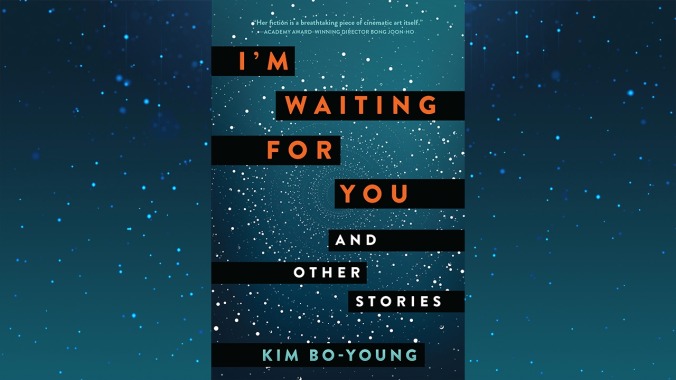Love and loss animate the cosmic tales of I’m Waiting For You

In the title story of I’m Waiting For You, the first of Korean science fiction writer Kim Bo-Young’s works to be translated into English, the unnamed protagonist says he felt he was prepared for solo space travel because he’d once spent a few months without leaving his home. After a year in which so much of the world has experienced an even more extreme version of such isolation, that idea might seem trite. But then the character goes on to explain how wrong he was:
That wasn’t actually living alone. I have never once really lived alone. Someone cleared away the trash I left out for collection, and emptied the septic tank… In another place they boiled noodles and put them in a dish and delivered them… I had never lived alone, not once. How would really living alone even be possible?
“I’m Waiting For You” was originally written in 2015 at the request of a fan who wanted Kim to write a story he could use to propose to his girlfriend. The tale of a man journeying through time and space in an increasingly desperate and unlikely attempt to reunite with his fiancée has taken on new power as we look toward the end of more than a year of isolation that has also produced a newfound understanding of how connected we are to the communities around us.
The story is accompanied by “On My Way To You,” a sequel Kim wrote as a gift to the fan’s wife. It explores the parallel journey of the original protagonist’s fiancée, and how the only thing worse than isolation is other people. Hers is a refugee narrative, examining how the overlooked find ways to seize agency. Read together, the pieces are as bittersweet and beautiful as Makoto Shinkai’s short film “Voices Of A Distant Star.”
I’m Waiting For You is less a conventional short story collection and more a pair of novellas accompanied by short sequels. While neither work needed continuation because of their excellent ambiguous endings, they prove to be worthy additions, building on Kim’s impressive mix of strong world-building and deep emotion.
The second main story, “The Prophet Of Corruption,” is far more complex, presenting a science fiction spin on Buddhism and Korean mythology. There’s an appendix of terms to make it easier for the uninitiated to keep up, but it’s most useful as a primer on the naming conventions and traditions Kim is drawing from. The high-concept cosmic story, reminiscent of David Mitchell’s Cloud Atlas and Isaac Asimov’s theological stories, follows Naban, a powerful entity capable of dividing themselves and reincarnating in the mortal Lower Realm in order to learn. But as they begin to question the value of the Lower Realm against their native Dark Realm, they set out on a quest to confront their firstborn child and restore balance to the world and themselves.
The result is an absolutely fascinating examination of karma, identity, suffering, and the very idea of the other. Naban battles doubts over their own strength while debating philosophy and the nature of the universe with other incomprehensibly powerful beings: There’s Fuxi, who believes that everyone deserves a perfect life on Earth and that suffering is pointless, and Tushita, a thoroughly alien entity that believes everyone would be happier if they merged their consciousnesses. Reminiscent of N.K. Jemisin’s The Hundred Thousand Kingdoms, the story also explores the strange fact that so many myths portray the interplay between gods as simultaneous parents, children, lovers, and rivals.
While “The Prophet Of Corruption” includes spaceships, power armor, and a trip to hell akin to Dante’s Inferno, its Buddhist roots distinguishes it from contemporary Western science fiction. The translation of Chinese author Liu Cixin’s The Three-Body Problem into English in 2014 helped set off a wave of interest in bringing East Asian science fiction to the English-speaking world, and Kim provides another example of the power that cross-cultural exchange can have in science fiction’s ability to expand the human imagination.
“That One Life,” the follow-up to “The Prophet Of Corruption,” is a slighter work than “On My Way To You,” but its alternating visions of how Naban and the world continue to change after the events of the original story are still compelling. Each feels like a seed for a different book.
I Am Waiting For You includes author notes on Kim’s inspirations for her stories and the initial reactions of the recipients of “I Am Waiting For You” and “On My Way To You,” which are charming but frustrating, as they reference numerous works by Kim that aren’t yet available in English. More valuable is the included correspondence between the book’s two translators, Sophie Bowman and Sung Ryu.
Bowman and Ryu explain their creative approaches, like drawing inspiration from The Odyssey and Madeline Miller’s Circe to evoke a mythical structure in “The Prophet Of Corruption,” where the original text is meant to emulate a Buddhist chant. As they worked throughout the COVID-19 pandemic on stories about isolation and longing, their letters parallel some of the stories themselves. For the translators or new readers, those stories inspired by love feel particularly powerful at a time when it seems like finding a better future together might finally be possible.
Author photo courtesy Kim Bo-Young